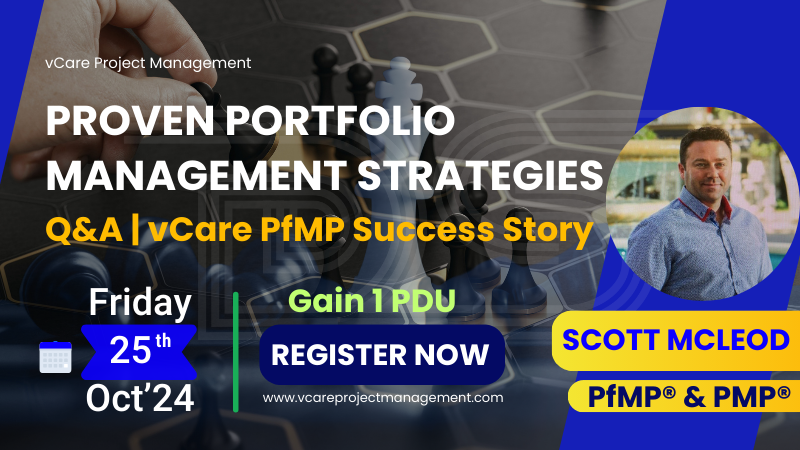
by DharamCW | Oct 4, 2024 | Professional Development Webinars
Proven Portfolio Management Strategies | Scott McLeod | vCare PfMP Success Story
I am excited to announce an exclusive webinar featuring Scott McLeod A.Sc.T, PMP, PfMP, a renowned industry leader in project and portfolio management, as the guest keynote speaker. This webinar promises to provide valuable insights into the evolving world of portfolio management.
Discussion Topics include but are not limited to,
• Role of certifications in ongoing professional development
• The importance of agility in portfolio management
• Aligning projects with organizational strategic goals
• How digital tools transform portfolio management processes
• Managing stakeholder expectations in large-scale projects
Attendees will gain expert knowledge, earn 1 PDU, and enjoy a special discount code for our upcoming PMP, PgMP, and PfMP programs.
🔗 Reserve your spot now: https://bit.ly/3Mx38kN
Session Date: Friday, 25TH October 2024
Session Time: 10:30 AM – 11:30 AM (PDT) / 11:30 AM – 12:30 PM (MDT) / 12:30 PM – 01:30 PM (CDT) / 01:30 PM – 02:30 PM (EDT) / 02:30 PM – 03:30 PM (BRT) / 06:30 PM – 07:30 PM (BST) / 07:30 PM – 08:30 PM (CEST) / 08:30 PM – 09:30 PM (AST) / 09:30 PM – 10:30 PM (GST)
🚀 Elevate Your Project Management Career:
– Book an obligation-free consultation session on Project Management Career, training, and certifications: http://talktodharam.com
– Discover training offers and certification discounts: https://bit.ly/3jWVepD
– Stay updated with our Q&A series and certification success stories by subscribing to the vCare Project Management YouTube channel at https://bit.ly/2YF0wJl
– Follow my podcasts and interviews with Project Management Experts on YouTube at https://bit.ly/2NDY8wd
#portfoliomanagementstrategies #portfoliomanagement #pfmp #pfmpwebinar #projectmanagement #agilemanagement #professionaldevelopment #vcaresuccess #digitaltransformation #stakeholdermanagement #projectsuccess #managementstrategies #certificationsmatter #strategicalignment #agilityinprojects #projectleadership #pmcommunity #pmi #askdharam #dharamsingh #vcareprojectmanagement
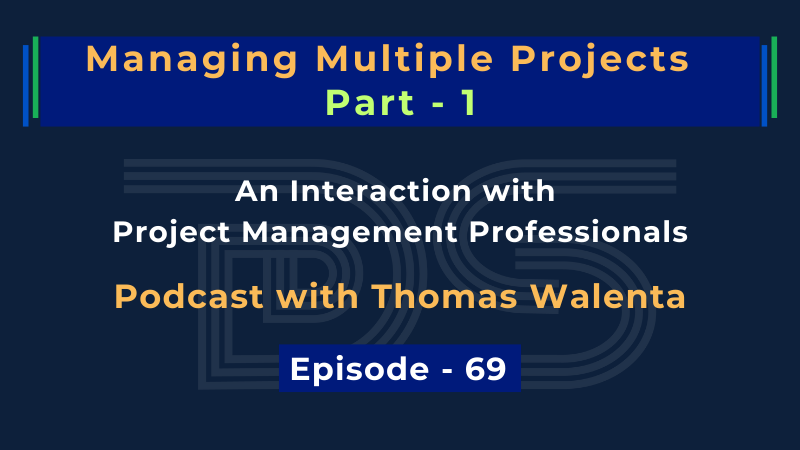
by DharamCW | Oct 3, 2024 | Podcast, Project-Program-Portfolio Management Knowledge
Managing Multiple Projects – Part 1 | Thomas Walenta | Dharam Singh | Episode 69
The following topics have been discussed in brief:
– As we incorporate AI into project management, it’s crucial to consider the viewpoints and worries of professionals from different generations, from Generation Alpha to Baby Boomers. How can AI improve project management efficiency and decision-making while ensuring inclusivity and collaboration across diverse generational teams? How do we tackle the changing roles and skill sets needed for success in this rapidly evolving landscape?
– In today’s rapidly changing business landscape, project managers often oversee multiple projects simultaneously. Given the increasing complexity and uncertainty, what do you believe are the most critical skills and qualities that project managers need to possess to navigate these challenges effectively?
– With project failures and scope creep prevalent, especially in managing multiple projects, what do you think is the root cause behind these challenges, and how can project managers proactively address them to ensure project success?
– How can investing in skilled project managers and leveraging technology optimize project investment and drive more value for organizations?
– Can you provide insights into how project and program managers should adapt their leadership styles when overseeing multiple initiatives?
🎥 Watch now: https://www.youtube.com/watch?v=vPOp2KfN9y4
🚀 Seize the opportunity to Elevate Your Project Management Career:
– Register for my upcoming PMI Certification Success Story Webinar: https://bit.ly/3Mx38kN
– Book an obligation-free consultation session on Project management Career, training, and certifications: http://talktodharam.com
– Discover training offers and certification discounts: https://bit.ly/3jWVepD
– Stay updated with our Q&A series and certification success stories by subscribing to the vCare Project Management YouTube channel at https://bit.ly/2YF0wJl
– Follow my podcasts and interviews with Project Management Experts on YouTube at https://bit.ly/2NDY8wd
#ProjectManagement #MultipleProjects #AIinPM #GenerationalDiversity #LeadershipSkills #ScopeCreep #ProjectSuccess #AgileManagement #AskDharam #DharamSingh
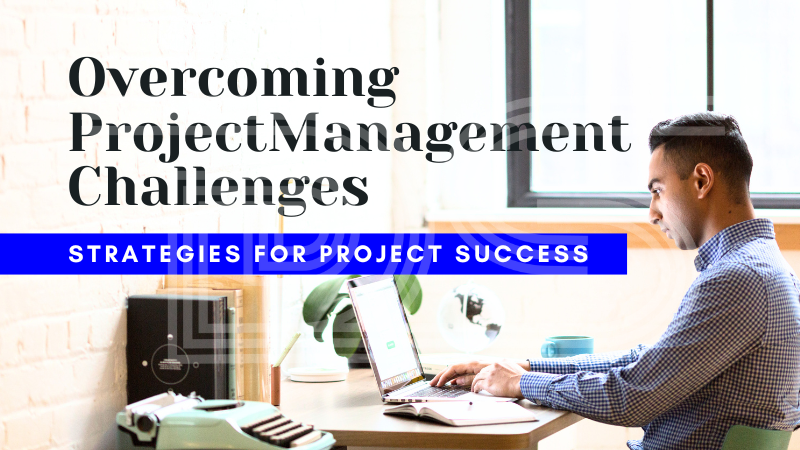
by DharamCW | Sep 30, 2024 | Industry Trends and Insights, Project Management
Overcoming Key Project Management Hurdles
Project management is often a complex and challenging process, requiring managers to navigate a maze of obstacles to achieve success. Here are the core challenges that today’s project managers must adeptly manage:
+ Unclear Goals: Setting clear objectives is crucial but often overlooked, leading to project misalignment.
+ Scope Creep: Projects can expand beyond original plans without rigorous scope control, affecting timelines and budgets.
+ Skill Gaps: Ensuring your team has the right skills is vital for project success but can be a significant hurdle.
+ Accountability Issues: A lack of clear responsibilities can lead to blame-shifting and inefficiencies.
+ Risk Management: Identifying and mitigating risks proactively is often underprioritized until issues arise.
+ Ambiguous Contingency Plans: Effective contingency planning is critical for navigating unexpected changes and risks.
+ Communication Breakdowns: Effective communication is the backbone of project success, yet it’s one of the most common failings.
+ Stakeholder Engagement: Engaging stakeholders appropriately can make or break project outcomes.
+ Digital Transformation: Integrating new technologies poses challenges but is essential for modern project environments.
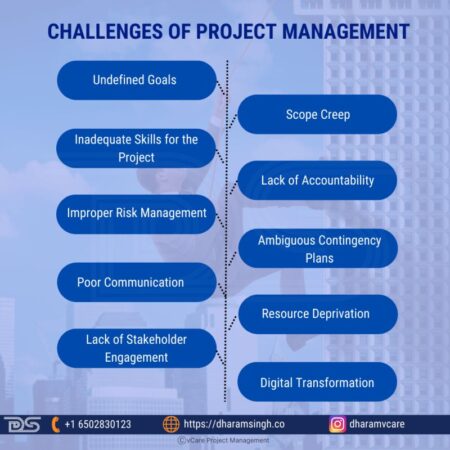
Master the challenges of project management with expert strategies for success.
🚀 Embrace the chance to Advance Your Project Management Career:
Register for my upcoming PgMP/PfMP Success Story Webinar: https://bit.ly/3TSx8fj
Book an obligation-free consultation session on Project management Career, training, and certifications: http://talktodharam.com
Discover training offers and certification discounts: https://bit.ly/3jWVepD
Stay updated with our Q&A series and certification success stories by subscribing to the vCare Project Management YouTube channel: https://bit.ly/2YF0wJl
Follow my podcasts and interviews with Project Management Experts on YouTube: https://bit.ly/2NDY8wd
#ProjectManagement #ProjectSuccess #PgMP #PfMP #ProjectManager #PMChallenges #RiskManagement #ScopeCreep #Leadership #DigitalTransformation #StakeholderEngagement #PMP #PMTraining

by DharamCW | Sep 25, 2024 | Leadership in Project Management, Project-Program-Portfolio Management Knowledge
Understanding what makes a project successful is crucial before starting any new venture. As a leading expert in project management, I’ve tried to identify four key success criteria that can transform your projects from ordinary to extraordinary:
1. On-Time Delivery: Completing projects within the scheduled timeline is paramount. It not only satisfies clients but also builds your reputation for reliability.
2. Budget Compliance: Staying within budget showcases your ability to manage resources efficiently, which is critical for financial success.
3. Achievement of Objectives: Meeting all outlined project objectives is a significant milestone that proves your team’s capability and effectiveness.
4. Positive Feedback: Positive feedback from stakeholders and clients clearly indicates a project’s overall success and impact.
Focusing on these elements can ensure your projects are not just completed but celebrated. As a leading PMP, PgMP, and PfMP trainer mentor, I’ve guided thousands of professionals to clear their PMI certifications. Ready to elevate your project management skills? Let’s connect!
🚀 Elevate Your Project Management Career:
– Register for my upcoming PMI Certification Success Story Webinars: https://bit.ly/4aVhrd6 / https://bit.ly/3QeVhKF
– Book an obligation-free consultation session on Project management Career, training, and certifications: http://talktodharam.com
– Discover training offers and certification discounts: https://bit.ly/3jWVepD
– Stay updated with our Q&A series and certification success stories by subscribing to the vCare Project Management YouTube channel at https://bit.ly/2YF0wJl
– Follow my podcasts and interviews with Project Management Experts on YouTube at https://bit.ly/2NDY8wd
#ProjectManagement #SuccessCriteria #ProjectSuccess #ProjectDelivery #PositiveFeedback #BudgetManagement #TimeManagement #ObjectiveAchievement #StakeholderFeedback #ClientSatisfaction #ProjectPlanning #ProjectGoals #AskDharam #DharamSingh #VCareProjectManagement
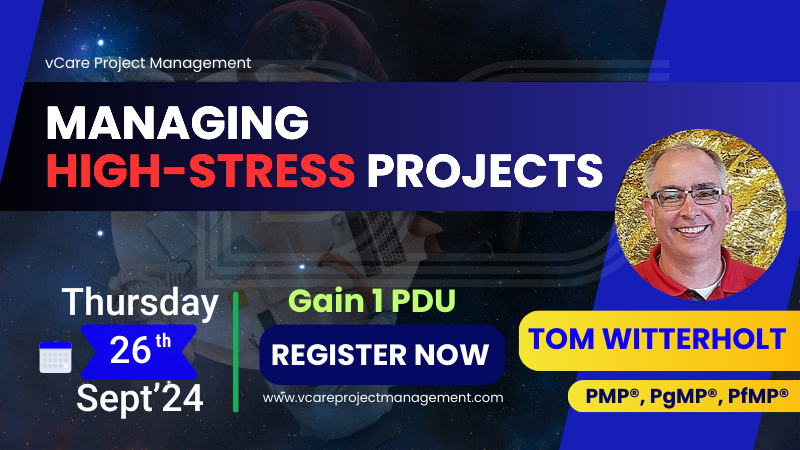
by DharamCW | Sep 6, 2024 | Professional Development Webinars
Managing High-Stress Projects | Tom Witterholt | vCare PgMP & PfMP Success Story
Join vCare Project Management for an exclusive webinar featuring Tom Witterholt, a highly accomplished Senior Program Manager with over 34 years of experience in the aerospace and defense sectors from Albuquerque, New Mexico, United States. As the keynote speaker, Tom will share his extensive expertise in managing high-stress projects.
Discussion Topics include but are not limited to,
+ Developing Strategic Thinking: Essential Skills and Learning Paths for Leaders
+ Transforming Underperformance: Leadership Techniques for Transforming Low-Performing Team Members
+ The Strategic Role in Organizational Change: How Strategy Drives Transformation
+ Navigating New Leadership Roles: Strategies for Success in Unfamiliar Territories
+ Interpreting Key Performance Indicators: Understanding and Addressing Misaligned Metrics
Attendees will earn 1 PDU and receive special discount codes for upcoming PMP®, PgMP®, and PfMP® programs. Don’t miss this chance to learn from an industry expert and take your project management skills to the next level.
🔗 Reserve your spot now: https://bit.ly/4fFJTTn
Session Date: Thursday, 26th September 2024
Session Time: 08:30 AM – 09:30 AM (HST) / 10:30 AM – 11:30 AM (AKDT) / 11:30 AM – 12:30 PM (PDT) / 12:30 PM – 01:30 PM (MDT) / 01:30 PM – 02:30 PM (CDT) / 02:30 PM – 03:30 PM (EDT) / 07:30 PM – 08:30 PM (BST) / 08:30 PM – 09:30 PM (CEST) / 09:30 PM – 10:30 PM (AST)
🚀 Elevate Your Project Management Career:
– Book an obligation-free consultation session on Project Management Career, training, and certifications: http://talktodharam.com
– Discover training offers and certification discounts: https://bit.ly/3jWVepD
– Stay updated with our Q&A series and certification success stories by subscribing to the vCare Project Management YouTube channel at https://bit.ly/2YF0wJl
– Follow my podcasts and interviews with Project Management Experts on YouTube at https://bit.ly/2NDY8wd
#HighStressProjects #ProjectManagement #FreeWebinar #PgMP #PfMP #PMI #LeadershipDevelopment #StrategicThinking #TransformationalLeadership #OrganizationalChange #PerformanceImprovement #LeadershipStrategies #ProgramManagement #DefenseIndustry #AerospaceSector #TeamManagement #StrategicLeadership #MetricsAnalysis #LeadershipSuccess #ChangeManagement #LeadershipExcellence #ProjectSuccess #ProjectLeadership #ProjectPlanning #ProjectDelivery #ProjectPortfolio #StressManagement #CrisisManagement #RiskManagement #PgMPCourse #PgMPTraining #PfMPCertification #PfMPCourse #AskDharam #DharamSingh #VcareProjectManagement










Recent Comments